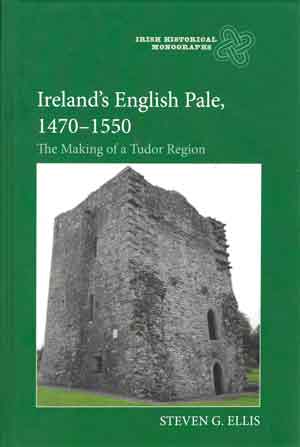IRELAND’S ENGLISH PALE, 1470–1550: the making of a Tudor region
Published in Book Reviews, Book Reviews, Issue 4 (July/August 2022), Reviews, Volume 30STEVEN ELLIS
Boydell
£75
ISBN 9781783276608
Reviewed by Ruth Canning
Ruth Canning is Senior Lecturer in Early Modern History at Liverpool Hope University.
Ireland’s English Pale is a region frequently discussed but very rarely defined. James Lydon’s 1967 article, ‘The problem of the frontier in medieval Ireland’, had, it seemed, settled the issue for many historians. He noted that 1446/7 was the earliest known mention of ‘the Pale’ as an identifiable term for what were known as ‘the four obedient shires’. The region was defined by a military frontier separating the English of Ireland from the indigenous Irish beyond. And, in addition to providing a greater understanding of the Pale’s limits, one of Lydon’s principal findings was that the late medieval Pale underwent a period of decline in the face of a Gaelic revival, and that it ‘was, on the whole, a complete failure’. An emphasis on the Pale’s late medieval decline, however, has helped to perpetuate exaggerated cultural claims by prejudiced contemporaries that the Pale’s inhabitants had become ‘more Irish than the Irish themselves’. This is a problem that Steven Ellis has set out to address.
Throughout a long and prolific career, Ellis encountered evidence about the Pale’s development that ‘seemed ambiguous, [and] even conflicting’ (p. ix). It indicated that the late medieval English Pale was undergoing significant expansion, not contraction. Moreover, rather than being the location of cultural ‘degeneration’ or ‘Gaelicisation’, as some late medieval and Tudor officials complained, the Pale was a paradigm of Anglicisation. Ellis has made these points in multiple publications over the years, yet the idea of a shrinking and Gaelicised medieval Pale has persisted in recent historiography. Thus, Ellis’s new book, Ireland’s English Pale, 1470–1550: the making of a Tudor region, aims to establish, in meticulous detail, the actual boundaries of Ireland’s late medieval Pale. Central to this study are three key assertions: (1) the Pale was not a failing entity; (2) it was undergoing expansion, not retraction; and (3) the Pale actually satisfied the impossible Tudor goal of Anglicising its indigenous Irish residents.
From about 1470, English monarchs’ Irish policies concentrated on the Pale, the centre of English government in Ireland. Their two chief goals were that the government would be self-financing and that the inhabitants of the Pale would bear the burden of defending the region without military intervention from England. Ellis asserts that the Pale was largely successful in these respects. Indeed, in the aftermath of the 1534 Kildare rebellion it became clear that ‘English rule had effectively been maintained, with the Pale now more populous, better defended, and its boundaries even enlarged, without the need for ongoing subventions in money and men from England’ (p. 145).
The ebb and flow of the Pale’s boundaries is traced through an examination of statutes, physical barriers, settlement patterns, estate ownership, rates of tillage, office-holding and the composition of juries. This evidence, which suggests that the Pale was larger than previously assumed, is underpinned by an inspection of rental income and taxation records because, as Ellis rightly asserts, ‘the best measure of the Pale’s limits was the ability of royal government to exercise control and raise taxes’ (p. 58). This analysis demonstrates that, long before the Tudors contemplated an Irish conquest, the earls of Kildare had already done much to extend the limits of counties Dublin, Kildare and Meath through military expansion, fortification and land improvement. This expansion is confirmed by Tudor subsidy assessments, which reveal a notable increase in tillage and taxation in formerly neglected baronies and lands appropriated from neighbouring Irish lordships.
The Pale was, first and foremost, a military frontier characterised by fortified settlements and defensive structures. Even taxation was geared primarily towards defence. Military obligations, established by legislation, were central to the Palesmen’s sense of identity and Englishness. Yet, as a military frontier, the Pale’s boundaries were not impermeable; the borders were also meant to be economically—and, by association, culturally—porous. Besides trade, a shortage of labour, combined with a growing area under tillage, meant that Irish migration was essential to satisfy the Pale’s labour needs. Cultural exchange was therefore inevitable. Nevertheless, Ellis argues that historians’ focus on the process of Gaelicisation within the Pale has been misleading: firstly, because the Pale’s English inhabitants were firmly attached to an English identity; and, secondly, because it obscures an inverse trend whereby Irish migrants were assimilated into Pale society. This occurred through the adoption of English customs and practices, like serving as jurors in English courts, acquiring English charters of freehold, adopting English names, and participating in cereal-based agriculture on traditionally organised English manors. Probably even more telling was their inclusion in statutes relating to the Pale’s defence; no longer considered Irish enemies, every ‘Irishman who dwells with Englishmen and speaks English’ was required to maintain ‘an English bow of his own length’ (p. 53). These examples of Irishmen adapting to aspects of English society do not obscure the fact that the Pale was a colonial society over which an English colonial élite presided. Ellis does argue, however, that the treatment of the Pale’s Irish residents was quite unlike that of later Tudor plantations. And, rather ironically, the Pale was the only place in Ireland that developed the kind of society envisaged by Henry VIII’s surrender and regrant policy (p. 168).
Ellis’s findings alter our understanding of how the Pale developed through the late medieval and early Tudor period and challenge historians to question accepted wisdom.

















